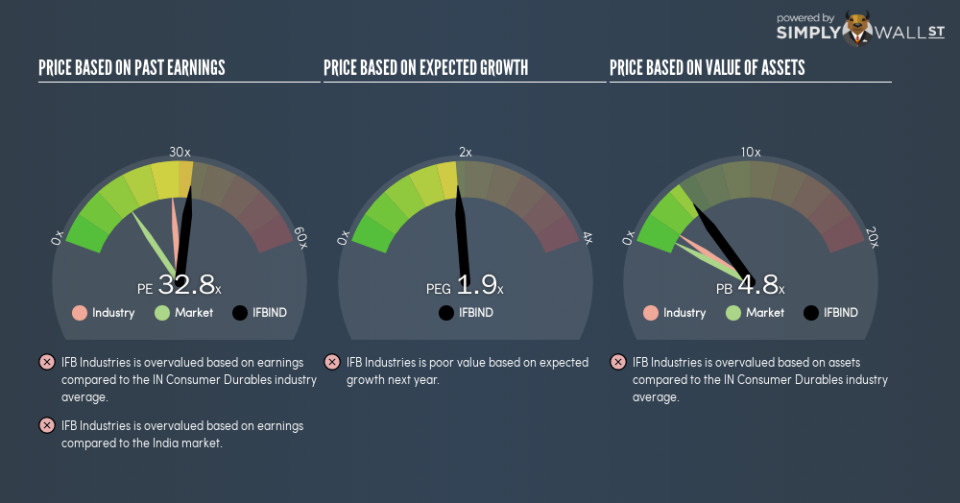Why IFB Industries Limited’s (NSE:IFBIND) High P/E Ratio Isn’t Necessarily A Bad Thing

Want to participate in a short research study? Help shape the future of investing tools and you could win a $250 gift card!
This article is written for those who want to get better at using price to earnings ratios (P/E ratios). We’ll look at IFB Industries Limited’s (NSE:IFBIND) P/E ratio and reflect on what it tells us about the company’s share price. Based on the last twelve months, IFB Industries’s P/E ratio is 32.83. That is equivalent to an earnings yield of about 3.0%.
See our latest analysis for IFB Industries
How Do I Calculate IFB Industries’s Price To Earnings Ratio?
The formula for P/E is:
Price to Earnings Ratio = Share Price ÷ Earnings per Share (EPS)
Or for IFB Industries:
P/E of 32.83 = ₹711.25 ÷ ₹21.66 (Based on the year to December 2018.)
Is A High Price-to-Earnings Ratio Good?
A higher P/E ratio means that investors are paying a higher price for each ₹1 of company earnings. That isn’t necessarily good or bad, but a high P/E implies relatively high expectations of what a company can achieve in the future.
How Growth Rates Impact P/E Ratios
Probably the most important factor in determining what P/E a company trades on is the earnings growth. That’s because companies that grow earnings per share quickly will rapidly increase the ‘E’ in the equation. That means unless the share price increases, the P/E will reduce in a few years. So while a stock may look expensive based on past earnings, it could be cheap based on future earnings.
Notably, IFB Industries grew EPS by a whopping 48% in the last year. And its annual EPS growth rate over 5 years is 21%. I’d therefore be a little surprised if its P/E ratio was not relatively high.
How Does IFB Industries’s P/E Ratio Compare To Its Peers?
We can get an indication of market expectations by looking at the P/E ratio. The image below shows that IFB Industries has a higher P/E than the average (28) P/E for companies in the consumer durables industry.
IFB Industries’s P/E tells us that market participants think the company will perform better than its industry peers, going forward. The market is optimistic about the future, but that doesn’t guarantee future growth. So investors should always consider the P/E ratio alongside other factors, such as whether company directors have been buying shares.
A Limitation: P/E Ratios Ignore Debt and Cash In The Bank
The ‘Price’ in P/E reflects the market capitalization of the company. That means it doesn’t take debt or cash into account. In theory, a company can lower its future P/E ratio by using cash or debt to invest in growth.
Such expenditure might be good or bad, in the long term, but the point here is that the balance sheet is not reflected by this ratio.
How Does IFB Industries’s Debt Impact Its P/E Ratio?
Since IFB Industries holds net cash of ₹782m, it can spend on growth, justifying a higher P/E ratio than otherwise.
The Verdict On IFB Industries’s P/E Ratio
IFB Industries trades on a P/E ratio of 32.8, which is above the IN market average of 15.5. Its strong balance sheet gives the company plenty of resources for extra growth, and it has already proven it can grow. Therefore it seems reasonable that the market would have relatively high expectations of the company
Investors have an opportunity when market expectations about a stock are wrong. People often underestimate remarkable growth — so investors can make money when fast growth is not fully appreciated. So this free visual report on analyst forecasts could hold they key to an excellent investment decision.
Of course, you might find a fantastic investment by looking at a few good candidates. So take a peek at this free list of companies with modest (or no) debt, trading on a P/E below 20.
To help readers see past the short term volatility of the financial market, we aim to bring you a long-term focused research analysis purely driven by fundamental data. Note that our analysis does not factor in the latest price-sensitive company announcements.
The author is an independent contributor and at the time of publication had no position in the stocks mentioned. For errors that warrant correction please contact the editor at editorial-team@simplywallst.com.


